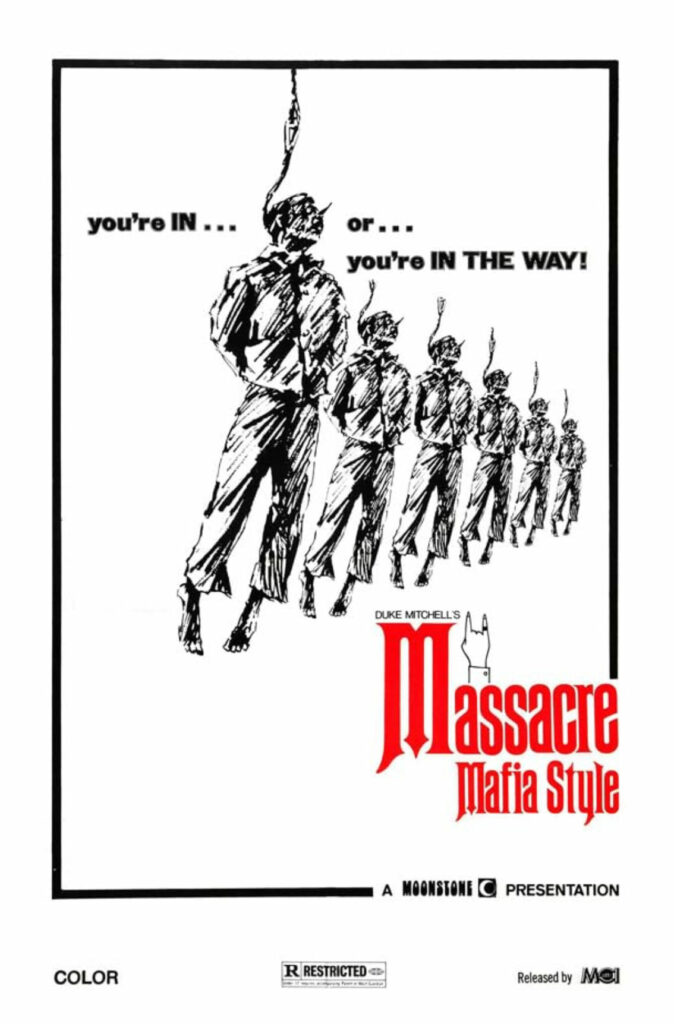Lounge crooner and self-styled King of Palm Springs, Duke Mitchell, was proud of his Italian heritage. After the Godfather flicks came out, Duke had some thoughts about the movies, and about how Italian-Americans are stereotyped in this country. So, he scrimped and saved, mortgaged and hustled, and made his very own mafia flick that was violent, preachy, cheap, and played into every single one of those negative stereotypes.
Written, produced, directed by, starring, and featuring songs sung by Duke Mitchell, Massacre Mafia Style tells the story of Mimi Miceli (Mitchell, credited under his birth name, Dominico Miceli). When Mimi was a teenager, his father, crime boss Don Mimi (Lorenzo Dardado), was deported back to Sicily, and the younger Mimi accompanied him. Now, he’s a grown man and a widower with a young son. The siren call of Los Angeles is ringing in his ears, so Mimi decides to head back to the States and make a name for himself as a gangster. He recruits childhood friend Jolly Rizzo (Vic Caesar), and the two begin their ascent by kidnapping and ransoming Chucky Tripoli (Louis Zito), who is the big guy in LA.
But, business is business, so all is forgiven, if not forgotten. Over the course of many, many years, Mimi’s fortunes rise and fall, usually concurrent with his and Jolly’s willingness to go on a murder spree. In between, the film has the feel of going to a red sauce restaurant or one of Paulie Cicero’s backyard cookouts. The atmosphere is steeped in Mitchell’s lounge sensibilities, and his Italian upbringing. It’s in these scenes that Mimi philosophizes about the plight of the Italian-American, lamenting how the men have been pushed into a violent lifestyle by rigid American laws, and the women are left to mourn.
There was something of a grievance industry surrounding Italian-Americans at the time, in the Italian-American Civil Rights League, founded by gangster Joe Colombo. Joe was shot in broad daylight at a rally for bringing eyes to La Cosa Nostra, and that moment is one of many real-life scenarios Mitchell adapted for the movie.
There’s more bloody violence, more hearty meals, more sermons, until denouement. The movie ends exactly how one would expect. It’s the journey that concerns viewers, and Mitchell’s storytelling  abilities are not spectacular.
abilities are not spectacular.
Quite a lot of time passes from Mimi’s arrival in Los Angeles until the end of the movie. But, the only indication time is passing is the growing prevalence of grey hair and mustaches, and occasional references to how old Mimi’s son is. The movie was released in 1974, and no matter what year the story happens to be in, it looks like 1974.
That’s easy to overlook, though. What shitty movie fans are looking for are the poor production values (check), substandard acting (check), ridiculous action sequences (check), and general b-movie hilarity (check). My favorite moment of shittiness in this flick happens in the opening scene, when Mitchell knocks over a table lamp and makes sure to right it before carrying on. It’s not much, but the vast majority of filmmakers would have decided to go with a different take. Little moments like that continue to pile on top of each other until the movie has a sangfroid that defies its objective quality.
There is something of a relentless nature to the film, as well, as if Mitchell didn’t want viewers contemplating things too much. The scenes tick off one after the other. Sometimes the movie is an airing of grievances, and sometimes it’s shameless exploitation. It really seems to come down to what mood Mitchell was in that day of filming.
Mitchell also didn’t shy away from racism. The most prominent black character in the movie is a pimp named Super Spook (Jimmy Williams), who gets on Mimi’s bad side, resulting in lots of hard R’s. An accurate portrayal of racist attitudes in the mafia, and American society at large? Unfortunately, yes, and while jarring, Mitchell had no hesitation in showing the bad side of the gangster lifestyle, and the bad attitudes that are still a feature of life in the States. The only glaring omission is drug use, which is nonexistent in the movie.
In tone and style, Massacre Mafia Style is kin to countless low-budget exploitation and crime flicks of the era, down to the million different shades of brown and yellow everywhere, and the fake blood that looks as if it were supplied by Sherwin-Williams.
This came close to being a lost film, but the folks at Grindhouse Releasing, including the late Sage Stallone, cleaned it up and gave it a new release. It was worth the effort. Massacre Mafia Style takes over the #102 spot in the Watchability Index from Speed Kills. Check it out.
